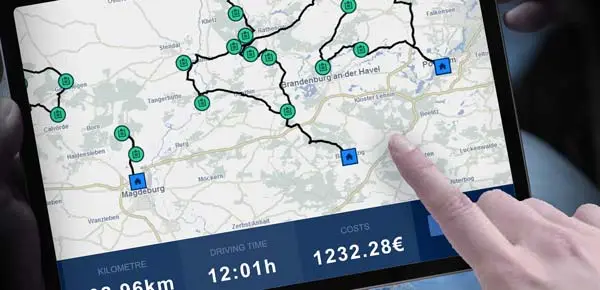
BLOG / SOLUTIONS · FIELD SERVICE OPTIMISATION
HOW TO DETERMINE AUTHENTIC FIELD SERVICE OPTIMISATION
28 February 2022 · James Alex Waldron
With thirty years of experience in the development of real-time field service software, we've complied a shortlist of questions to assist you in determining an authentic field service solution—and away from inferior optimisation.
QUESTION 1
WHAT IS FIELD SERVICE OPTIMISATION?
Defined as 'the action of making the best or most effective use of a situation or resource'. Translated to field service, it specifically describes a software that continually produces the best outcome across appointment scheduling and route planning according to your specific parameters. Authentic optimisation will consider and calculate instructions using millions of data points, including any SLA/KPI.It will not force a head office to choose from a 'pick list' of outcomes; nor will it require manual intervention if conditions change in-shift.
QUESTION 2
WHAT IS 'REAL TIME'?
The proliferation of terms such as 'real time', 'dynamic', and 'always on' leaves the field software market saturated with look-alike products. Real time really means 'live', as in 'simultaneous' or 'right now'. Authentic real-time optimisation continuously tracks and manages sources including scheduling and appointment generation/booking, route and tour planning, two-way digital connection with field operatives, self-service web portals, and customer engagement. It should produce outcomes recognising intervention factors such as location, traffic, weather, resource skills, time-of-day (and many more).If the solution only offers 'batched or overnight' optimisation, then the solution is not 'real time'.
QUESTION 3
TELL ME ABOUT ALGORITHMS
At the heart of a scheduling system is an algorithm. Simply put, this is the set of instructions that works in the background to simulate and solve complex field service scheduling. You don't have to understand the world of data science to gain an insight into the quality of an algorithm. It's obvious that for true optimisation it must be configurable and can handle unlimited complex rules in real time. Question if it was built and remains 'owned' by the field software developer. Ask for examples about how it continues to develop and how its machine learning capability offers optimisation unique to your workflows. Consider this example; geolocation data determines a field resource must walk 10 flights of stairs to a regular customer's site.If the algorithm cannot determine that this appointment type always takes longer than 'gantt chart filling' allows, then it is likely out-dated and the provider may a lack modern development approach.
QUESTION 4
HOW DO YOU SOURCE LOCATION DATA?
The advantage of a system's mapping data may be graded in one word: accuracy. This is; the quality of precision and the age of the data. With the trillions of data strings required to create authentic optimisation value, the results are degraded without geolocation. A system that considers these dimensions should therefore calculate the fastest outcome, not the shortest. Identifiers such as side of street, one-way streets, junctions, and time-of-day driving data for trillions of journeys all contain geocode elements and should be considered in the routes produced. Further data-driven positions power optimised results, such as factoring ongoing roadworks.A system without geolocation cannot for instance, schedule against genuine distances, travel times, or track a resource to announce a time of arrival.
DISCUSS YOUR SCHEDULING TEST TODAY
How can Project Teams ensure their Field Optimisation Software shortlist stands up to their SLA objectives? What must you demand from a considered provider? This critical stage of the selection process must be completed before final evaluation and contract.The most important test for optimisation software.
QUESTION 5
HOW DO YOU OPTIMISE FIELD SCHEDULING?
Head office, field resources, and customers all need assurance that service contracts will meet or exceed expectations. Optimisation software requires 'elasticity' in the data types it can consider. A unique dataset of rules are determined via service processes, customer management (in some cases, using data from ERP or CRM), and costs. With additional value derived from no region/postcode patches and single server processing, thorough planning is completed by as few dispatchers as possible. The short answer: results are an exact differentiation of cost between appointments. Whether this is technical Field Service or Last Mile (logistics/white glove) configurable specialisms (such as skills, weight/volume, spare parts, vehicles available) contribute to the calculated cost outcome. Optimisation must occur at appointment, with every adjustment, completion, and cancellation (again, in real time).If the algorithm cannot offer pre-optimised appointment windows, geolocated and cost-parametered in real-time, then this is not authentic field optimisation.
QUESTION 6
WHERE IS THE TRANSPARENCY?
The 'elasticity' an optimisation algorithm uses to produce the best outcome works in the background, continuously and with results in seconds. True optimisation means an organisation can choose its dispatch approach, from manual to fully automatic (it will permit and account for easy configuration when manual intervention is required). Most field service systems offer multi-channel communication with clients (sometimes through web-based features) and a permanent mobile connection to your resources. An optimal platform experience will further use the transparency provided by these data sources.It will provide powerful, transparent insight as to why it produced the results and the tools to assist escalation.
QUESTION 7
DO YOU UNDERSTAND MY INDUSTRY?
What is authentic field service optimisation specific to your industry or sector? When appointment costs are solved, where is the added value? Strict SLAs for 'repairing secure entry barriers' translate to the scheduling of reactive maintenance appointments. Multi-skilled tradespeople, each with a concurrent window required to 'service a void unit (in Housing)' translates to complex relations—team creation and linked appointments. To extend beyond published case studies, examine the solution's user community and its contribution to the discussion. What is the provision for technical expertise when a solution only appears to provide optimisation against a single need? What is the developer's commitment to meet your sector's best practice standards and growing challenges?Deep technical or managerial experience within your sector must match with demonstrated features and benefits, within a context you recognise.
Learn more about this topic and more in the e-book Designing Value: The Case for Real-Time Field Service
TALK TO FLS ABOUT FIELD SERVICE OPTIMISATION
To gain an understanding of tools to optimise the field experience for your workforce and customers book a short discussion or contact us at info@fastleansmart.com. Not quite ready? You can also find further answers in our FAQs.Read more:
FLS FAQs: dig deeper into integration, training, and security
Field Service Automation: next generation field service
Why smart Field Service Automation needs Smart Data
Professional Route Planning Software: Are you ready?

JAMES ALEX WALDRON
UK Marketing Manager
+44(0) 1183 800189
Send email
James Alex Waldron has worked in written communications for over 15 years. Since 2021, he has written for FLS and the Solvares Group on the topics of digital field service transformation and mobile workforce management, and regularly provides insight to the industry press.





